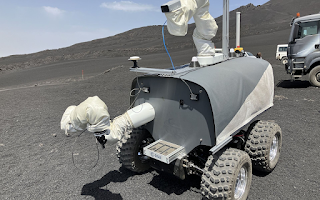420

Exploration of the Moon has been gaining more and more popularity across the globe. Every single step in space research is more likely to develop a human presence on another celestial body in the solar system. Recently, European Space Agency (ESA) took a step toward lunar exploration by completing its Analog-1 rover. This test was successfully conducted on the slopes of Italy’s Mount Etna and will enable astronauts to control a rover on the moon from the Lunar Gateway, reported Universe Today.
Image Credits: Universe Today
What is the ESA’s Analog-1 mission?
Analog-1 has been a long-standing mission of ESA to model what it would be like for a human to control a rover on the Moon’s surface while floating above it in the Gateway Space Station. This Gateway will serve as a base for many lunar exploration activities when it is ready to be launched.
The European Space Agency and the German Space Agency (DLR) were involved in the remote test of the rover on Mt Etna. The location served as an analogue for the lunar surface. This project was meant to test technologies that will help astronauts control the robot on the Moon from Earth.
The test began on June 12 2022 and lasted for four weeks till July 9 2022. During the mission, the European astronaut Thomas Reiter controlled the rover named ‘Interact’ located 2600 meters up on Mt Etna from a hotel room 23 kilometres away in the Italian town of Catania.
What did the rover do on Mount Etna?
Reiter controlled a 300-kilogram four-wheeled rover which was equipped with a stereo camera mast, gripper and camera arms. Interact explored the volcanic surface of Mt Etna along with two other rovers, Lightweight Rover Units 1 and 2, belonging to the German Aerospace Centre. The stationary lunar lander provided the rover with power and Wi-Fi, surface mapping was performed by the drone, and the Scout (centipede-like crawler) served as a relay between the lander and the rover.
Reiter commanded the rover to collect rocks using controls, and the system was set in his room. It was also guided by controllers in a control room which was set in another room since the astronaut and the controller will be physically separated during an actual mission.
Why is the rover on Mt Etna important for the Moon mission?
European Space Agency has prepared for a future moon mission, a part of NASA’s Artemis program, where it plans to land a rover on the lunar surface. The purpose of this rover will be to collect rock and soil samples for their analysis on Earth. The Interact rover possesses the technology that allows its controllers to explore the surface in the same way it does on Mt Etna, including the weight of the rocks and their cohesion. ESA hopes to launch this rover and control system into action by the end of this decade.
Follow us on Medium!

